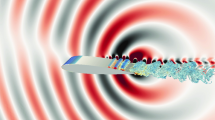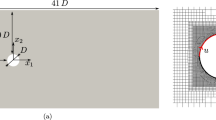Abstract
A low-order point vortex model for the two-dimensional unsteady aerodynamics of a flat plate wing section is developed. A vortex is released from both the trailing and leading edges of the flat plate, and the strength of each is determined by enforcing the Kutta condition at the edges. The strength of a vortex is frozen when it reaches an extremum, and a new vortex is released from the corresponding edge. The motion of variable-strength vortices is computed in one of two ways. In the first approach, the Brown–Michael equation is used in order to ensure that no spurious force is generated by the branch cut associated with each vortex. In the second approach, we propose a new evolution equation for a vortex by equating the rate of change of its impulse with that of an equivalent surrogate vortex with identical properties but constant strength. This impulse matching approach leads to a model that admits more general criteria for shedding, since the variable-strength vortex can be exchanged for its constant-strength surrogate at any instant. We show that the results of the new model, when applied to a pitching or perching plate, agree better with experiments and high-fidelity simulations than the Brown–Michael model, using fewer than ten degrees of freedom. We also assess the model performance on the impulsive start of a flat plate at various angles of attack. Current limitations of the model and extensions to more general unsteady aerodynamic problems are discussed.
Similar content being viewed by others
References
Alben S., Shelley M.J.: Flapping states of a flag in an inviscid fluid: bistability and the transition to chaos. Phys. Rev. Lett. 100, 074301 (2008)
Ansari, S.A., Zbikowski, R., Knowles, K.: Non-linear unsteady aerodynamic model for insect-like flapping wings in the hover. Part 1: methodology and analysis. Proc. IMechE Part G J. Aerosp. Eng. 220, 61–83 (2006)
Ansari, S.A., Zbikowski, R., Knowles, K.: Non-linear unsteady aerodynamic model for insect-like flapping wings in the hover. Part 2: implementation and validation. Proc. IMechE Part G J. Aerosp. Eng. 220, 169–186 (2006)
Berman G.J., Wang Z.J.: Energy-minimizing kinematics in hovering insect flight. J. Fluid Mech. 582, 153–168 (2007)
Brown C.E., Michael W.H.: Effect of leading edge separation on the lift of a delta wing. J. Aerosp. Sci. 21, 690–694 (1954)
Chen K.K., Colonius T., Taira K.: The leading-edge vortex and quasisteady vortex shedding on an accelerating plate. Phys. Fluids 22(3), 033601 (2010)
Clements R.R.: An inviscid model for two-dimensional vortex shedding. J. Fluid Mech. 57(2), 321–336 (1973)
Cortelezzi L., Leonard A.: Point vortex model of the unsteady separated flow past a semi-infinite plate with transverse motion. Fluid Dyn. Res. 11, 263–295 (1993)
Davis, C.I.R., Shajiee, S., Mohseni, K.: Lift Enhancement in a Flapping Airfoil by an Attached Free Vortex and Sink. AIAA Paper 2009-0390 (2009)
Dore, B.D.: The Unsteady Forces on Finite Wings in Transient Motion. Technical report 3456. Aeronautical Research Council (1966)
Edwards R.H.: Leading edge separation from delta wings. J. Aerosp. Sci. 21, 134–135 (1954)
Eldredge, J., Wang, C.: High-Fidelity Simulations and Low-Order Modeling of a Rapidly Pitching Plate. AIAA Paper 2010-4281, 40th AIAA Fluid Dynamics Conference, Chicago (2010)
Eldredge J.D.: Numerical simulation of the fluid dynamics of 2D rigid body motion with the vortex particle method. J. Comput. Phys. 221, 626–648 (2007)
Eldredge J.D.: A reconciliation of viscous and inviscid approaches to computing locomotion of deforming bodies. Exp. Mech. 50(9), 1349–1353 (2009)
Eldredge J.D., Toomey J., Medina A.: On the roles of chord-wise flexibility in a flapping wing with hovering kinematics. J. Fluid Mech. 659, 94–115 (2010)
Eldredge, J.D., Wang, C., Ol, M.V.: A Computational Study of a Canonical Pitch-up, Pitch-down Wing Maneuver. AIAA Paper 2009-3687 (2009)
Gendrich C.P., Koochesfahani M.M., Visbal M.R.: Effects of initial acceleration on the flow field development around rapidly pitching airfoils. J. Fluids Eng. 117, 45–49 (1995)
Graham, J.M.R.: The forces on sharp-edged cylinders in oscillatory flow at low Keulegan–Carpenter numbers. J. Fluid Mech. 97(1), 331–346 (1980)
Granlund, K., Ol, M.V., Garmann, D.J., Visbal, M.R., Bernal, L.: Experiments and Computations on Abstractions of Perching. AIAA Paper 2010-4943, 28th AIAA Applied Aerodynamic Conference, Chicago (2010)
Grauer J., Ulrich E., Hubbard J., Pines D., Humbert J.S.: Testing and system identification of an ornithopter in longitudinal flight. J. Aircr. 48(2), 660–667 (2010)
Jones, K.D., Platzer, M.F.: Flapping-Wing Propulsion for a Micro Air Vehicle. AIAA Paper 2000-0897 (2000)
Jones M.A.: The separated flow of an inviscid fluid around a moving flat plate. J. Fluid Mech. 496, 405–441 (2003)
Jones, R.T.: The Unsteady Lift of a Wing of Finite Aspect Ratio. Technical report 681, NACA (1939)
Katz J., Weihs D.: Behavior of vortex wakes from oscillating airfoils. AIAA J. 15(12), 861–863 (1978)
Koochesfahani M.M., Smiljanovski V.: Initial acceleration effects on flow evolution around airfoils pitching to high angles of attack. AIAA J. 31(8), 1529–1531 (1993)
Krasny, R.: Vortex sheet computations: roll-up, wake, separation. In: Lectures in Applied Mathematics, vol. 28, pp. 385–402. AMS (1991)
Krechetnikov R., Marsden J.E., Nagib H.M.: A low-dimensional model of separation bubbles. Phys. D 238, 1152–1160 (2009)
McCroskey W.J.: Unsteady airfoils. Ann. Rev. Fluid Mech. 14, 285–311 (1982)
Michelin S., Llewellyn Smith S.G.: An unsteady point vortex method for coupled fluid–solid problems. Theor. Comput. Fluid Dyn. 23, 127–153 (2009)
Michelin S., Llewellyn Smith S.G.: Falling cards and flapping flags: understanding fluid–solid interactions using an unsteady point vortex model. Theor. Comput. Fluid Dyn. 24, 195–200 (2010)
Milano M., Gharib M.: Uncovering the physics of flapping flat plates with artificial evolution. J. Fluid Mech. 534, 403–409 (2005)
Milne-Thomson L.M.: Theoretical Hydrodynamics. Dover Publications, Inc., New York (1996)
Mourtos N.J., Brooks M.: Flow past a flat plate with a vortex/sink combination. J. Appl. Mech. 63, 543–550 (1996)
Nitsche M., Krasny R.: A numerical study of vortex ring formation at the edge of a circular tube. J. Fluid Mech. 276, 139–161 (1994)
Ol M.V., Eldredge J.D., Wang C.: High-amplitude pitch of a flat plate: an abstraction of perching and flapping. Int. J. Micro Air Veh. 1(3), 203–216 (2009)
Pitt Ford, C.W., Babinsky, H.: Lift and the Leading Edge Vortex. AIAA Paper 2012-0911 (2012)
Polhamus, E.C.: A Concept of the Vortex Lift of Sharp-Edge Delta Wings Based on a Leading-Edge-Suction Analogy. Technical report TN D-3767, NASA (1966)
Pullin D.I.: The large-scale structure of unsteady self-similar rolled-up vortex sheets. J. Fluid Mech. 88(3), 401–430 (1978)
Pullin D.I., Wang Z.J.: Unsteady forces on an accelerating plate and application to hovering insect flight. J. Fluid Mech. 509, 1–21 (2004)
Ramesh, K., Gopalarathnam, A., Ol, M.V., Granlund, K., Edwards, J.R.: Augmentation of Inviscid Airfoil Theory to Predict and Model 2d Unsteady Vortex Dominated Flows. AIAA Paper 2011-3578 (2011)
Rossow V.J.: Lift enhancement by an externally trapped vortex. J. Aircr. 15(9), 618–625 (1978)
Saffman P.G., Sheffield J.S.: Flow over a wing with an attached free vortex. Stud. Appl. Math. 57, 107–117 (1977)
Sedov L.I.: Two-Dimensional Problems in Hydrodynamics and Aerodynamics. New York, London (1965)
Shukla R.K., Eldredge J.D.: An inviscid model for vortex shedding from a deforming body. Theor. Comput. Fluid Dyn. 21, 343–368 (2007)
Tchieu, A.A., Leonard, A.: A discrete-vortex model for the arbitrary motion of a thin airfoil with fluidic control. J. Fluids Struct. 27(5–6), 680–693 (2011) (submitted)
Theodorsen, T.: General Theory of Aerodynamic Instability and the Mechanism of Flutter. TR-496, NACA (1935)
Visbal M.R.: Dynamic stall of a constant-rate pitching airfoil. J. Aircr. 27(5), 400–407 (1990)
von Kármán T., Sears W.R.: Airfoil theory for non-uniform motion. J. Aeronaut. Sci. 5(10), 379–390 (1938)
Wagner, H.: Über die Entstehung des dynamischen Auftriebes von Tragflügeln. Zeitschrift für Angewandte Mathematik und Mechanik 5(1), 17–35 (1925)
Wang Z.J., Birch J.M., Dickinson M.H.: Unsteady forces and flows in low Reynolds number hovering flight: two dimensional computations vs robotic wing experiments. J. Exp. Biol. 207, 449–460 (2004)
Author information
Authors and Affiliations
Corresponding author
Additional information
Communicated by T. Colonius.
Rights and permissions
About this article
Cite this article
Wang, C., Eldredge, J.D. Low-order phenomenological modeling of leading-edge vortex formation. Theor. Comput. Fluid Dyn. 27, 577–598 (2013). https://doi.org/10.1007/s00162-012-0279-5
Received:
Accepted:
Published:
Issue Date:
DOI: https://doi.org/10.1007/s00162-012-0279-5




